Construction of the Research Hop Yard Has Begun! (2011)
go.ncsu.edu/readext?466675
en Español / em Português
El inglés es el idioma de control de esta página. En la medida en que haya algún conflicto entre la traducción al inglés y la traducción, el inglés prevalece.
Al hacer clic en el enlace de traducción se activa un servicio de traducción gratuito para convertir la página al español. Al igual que con cualquier traducción por Internet, la conversión no es sensible al contexto y puede que no traduzca el texto en su significado original. NC State Extension no garantiza la exactitud del texto traducido. Por favor, tenga en cuenta que algunas aplicaciones y/o servicios pueden no funcionar como se espera cuando se traducen.
Português
Inglês é o idioma de controle desta página. Na medida que haja algum conflito entre o texto original em Inglês e a tradução, o Inglês prevalece.
Ao clicar no link de tradução, um serviço gratuito de tradução será ativado para converter a página para o Português. Como em qualquer tradução pela internet, a conversão não é sensivel ao contexto e pode não ocorrer a tradução para o significado orginal. O serviço de Extensão da Carolina do Norte (NC State Extension) não garante a exatidão do texto traduzido. Por favor, observe que algumas funções ou serviços podem não funcionar como esperado após a tradução.
English
English is the controlling language of this page. To the extent there is any conflict between the English text and the translation, English controls.
Clicking on the translation link activates a free translation service to convert the page to Spanish. As with any Internet translation, the conversion is not context-sensitive and may not translate the text to its original meaning. NC State Extension does not guarantee the accuracy of the translated text. Please note that some applications and/or services may not function as expected when translated.
Collapse ▲7/9/2022 – Over eleven years ago we started our hops research program in Mills River. The article below documents it. Look for more recent articles to see what we have accomplished since then. (Breeding hops for the Southeastern US is now our primary focus; and we are making great progress)
4/20/2011 – People have been asking me when we were going to build the research hop yard we’ve been talking about! It’s finally happening, right now; and here are a few pictures to show you how we are doing it.
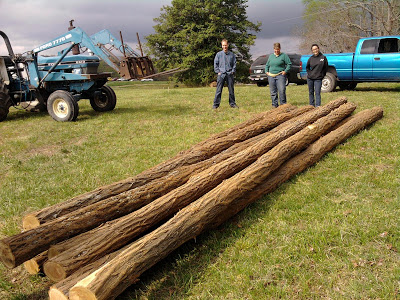
My staff and the research station staff have just been amazing on this project. We don’t really have any hop growing experts in this immediate region, so we are learning as we go. Our local hop growers have been so helpful. They’ve let us visit their sites, study their designs, and have answered many phone calls and emails. We are trying to make this hop yard compliment the one constructed last year on the NC State Lake Wheeler Road Field Laboratory in Raleigh by Rob Austin and Scott King (https://newcropsorganics.ces.ncsu.edu/specialty-crops/nc-hops/). We are working together on this statewide hop project and both yards are designed to help our young hop industry answer questions on how to grow the best hops in the Southeast. But the Raleigh hop yard is 12 feet tall, which is shorter than the conventional hop trellis. Rob and Scott cite their reasons for building a shorter trellis and I think we will gain valuable information from that. But our local growers, who have been producing for 2-4 years now, seem convinced that a tall trellis increases yields. So we went with a 20 foot trellis.
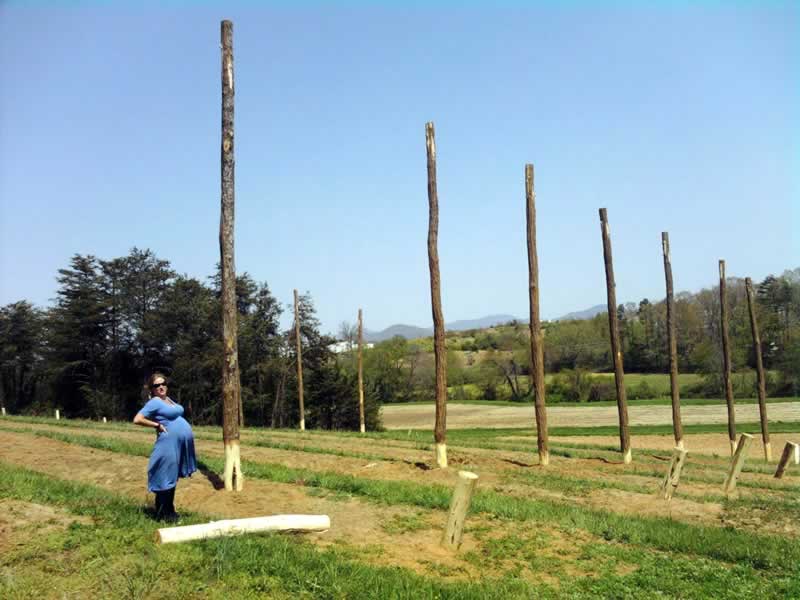
The research station crew did a fabulous job erecting the poles; being inspected by a very pregnant Amy!
The pictures here represent several months of work on the part of my new employee, Kelly Gaskill and two of our research station staff (I haven’t asked them if I can put their names online or not; so they will remain nameless right now). With no prior experience with growing hops, Kelly studied hop yards from across the world (via the internet), visited local hop yards, drew out many plans, and sourced materials. Now they are all in the field, making those plans a reality.
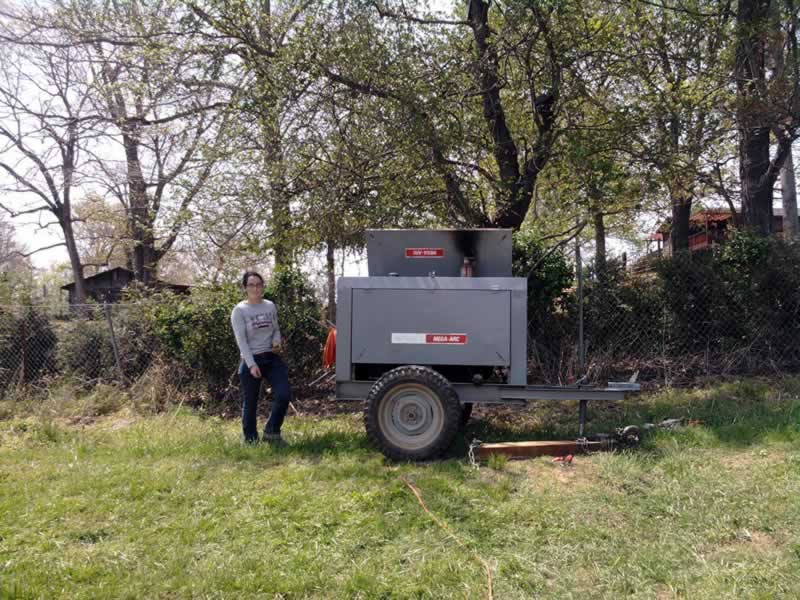
Emily found having a generator on site was very helpful for operating all the power equipment.
We thank the NC Department of Agriculture & Consumer Services for the USDA Specialty Crops Block grant that is funding the establishment of this research hop yard and our continued work with our cooperating hop farmers, Van Burnette, Julie Jensen, Rita Pelczar and John Wright, and Stephanie Willis. This project is tightly linked with the one Rob Austin leads with funding from the GoldenLeaf Foundation. Sue Colucci, Henderson Co. Extension, Hannah Burrack, Extension entomologist on campus, and Bill Yarborough, NCDA&CS agronomist, are also involved so we can help advise growers on disease and insect control, soil fertility, and all other aspects of production. Please see my other blog posts on hops to get information on others working with this industry including Chris Reedy at Blue Ridge Food Ventures, Sarah Schober at the Natural Products Laboratory, and Melinda Roberts and Tim Mathews with Extension.
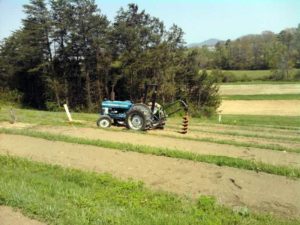
This was the tractor mounted auger that was used for digging the post holes.
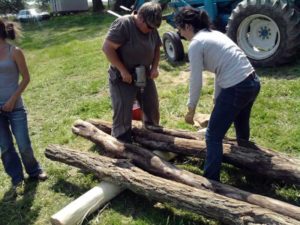
Vicky drilled the holes for the hardware before we set the poles in the ground!
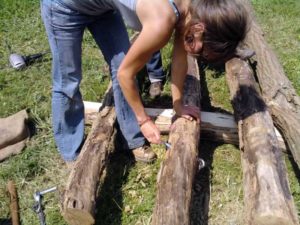
Kelly attaching the hardware.
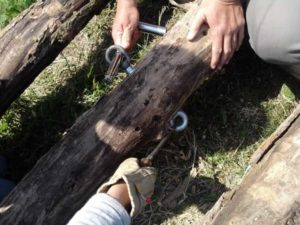
Close up of some of that hardware.

These anchors are here to stay!
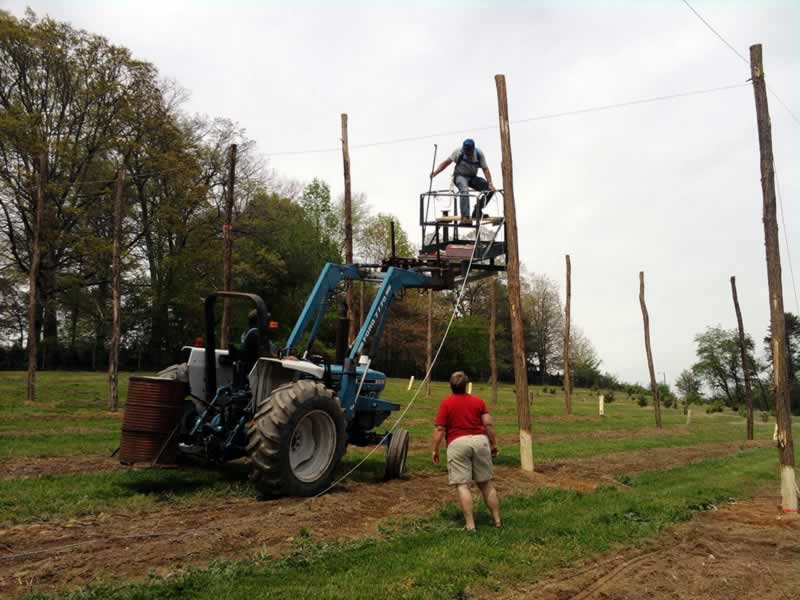
Now the cables are being attached.


